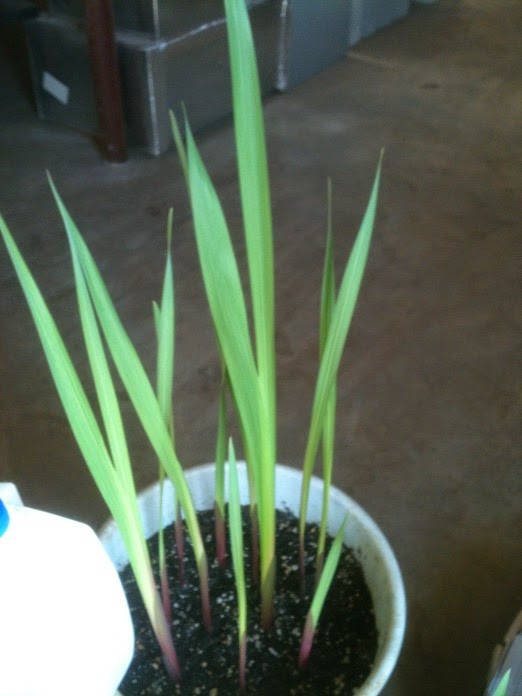Our 'Sweet Scarlet' Goumi bush is in full bloom and really smells great! It reminds me of the scent of some of the more fragrant Viburnums. Looking forward to another heavy crop of berries this year, and maybe some more bright red, sweet and tart, fruit leather. I'm gonna have to plant more of these... so productive and no disease or bug problems. The only complaint would be the work it takes to pick all those little berries.
... growing and hybridizing all kinds of plants in zone 6b Maryland since the 1980's.
Tuesday, April 28, 2015
Cool flower form Viola hybrid
Before it got too dark out, I went out and got a couple better pictures of that F2 seedling (from Viola arvensis X pansy) that has the cool flower form of Viola arvensis, only bigger and all yellow. It's definitely NOT your average round and ruffled modern pansy!
F2 of Viola striata X walteri (syn. Viola X cooperrideri)
These are some of the re-select second generation seedlings from my cross of Viola striata X Viola walteri. I'm trying to cull out the less appealing ones so that only these better ones will sow seed for future generations.
Wouldn't it be great to get pretty foliage and flowers and rebloom all combined into one plant!
This is a fairly large flowered blue-purple that tends to be more prostrate growing from the start.
This one has a more upright compact habit early in the Spring (they all make neat mats by mid-summer). It was especially heavy flowering last year.
Two white flowered ones with purple undersides of the foliage.
And a completely white, with green foliage - this one rebloomed fairly early last Fall.
Wouldn't it be great to get pretty foliage and flowers and rebloom all combined into one plant!
Cowpea hybrids
Several years ago I crosses a plain old grocery store black eye pea with 'Tetapeche Grey Mottled' cowpea (that I got from Native Seeds/SEARCH about 20 years ago). The first generation hybrids all produced black seeds with a little bit of lighter speckling. As the generations have advanced, other colors and patterns have started showing up. I've been selecting out some of the prettier ones to try to develop into lines. Here's an overview picture of nine of the "lines in the works"...
and close-ups of eight of them.
That one on the far-right I call Eagle Eye because the pattern reminds me of a bird silhouette.
Viola rostrata and Allium tricoccum
I'm hopeful that these two natives have decided to settle in and multiply. They've been in these spots for several years now.
Spurred blue violet (notice the upturned spurs behind the flowers)
Viola rostrata
and wild leeks, also known as "ramps"
Allium tricoccum
F2 Viola arvensis hybrids
These earliest ones aren't too exciting but there are still a lot more on the way. The most interesting to me, are the lower left and center bottom ones. The lower left one is actually completely yellow (and very intensely yellow at that) and has an interesting flower form that is reminiscent of Viola arvensis itself only bigger. The one on the bottom center has the coloring of Viola arvensis but has a small, round, ruffled flower form.
Wednesday, April 1, 2015
Gladiolus update
Here are the 'Red Majesty' gladiolus growing down in the basement. There's a gallon milk jug in the picture for scale. I staggered the plantings to try to spread out bloom, which I'm hoping to have by late April.
The earliest planted batch...
The earliest planted batch...
Thrips trouble
The last two seasons of indoor seed starting haven't gone very well. Last year, damping off was a big problem, but so far so good this year for that. Still, I'm battling with thrips though. You wouldn't think such a tiny bug would be capable of so much damage, but they pretty much killed any kale seedling last year (that didn't die from damping off first). This year I've been hand "squishing/rubbing" every one I see, pretty much daily. That's kept the damage to an acceptable level, but if I miss a day...
If anyone knows of a good organic trick for combatting these little pests on indoor plantings, please let me know. The first year I had so much trouble with them that I grudgingly resorted to trying pyrethrin spray but that didn't seem to make any difference.
Here are the tell tale white speckled areas that the thrips have caused on a small kale seedling.
And a little closer...
If anyone knows of a good organic trick for combatting these little pests on indoor plantings, please let me know. The first year I had so much trouble with them that I grudgingly resorted to trying pyrethrin spray but that didn't seem to make any difference.
Here are the tell tale white speckled areas that the thrips have caused on a small kale seedling.
This bigger kale seedling also has some spots and you can see one of the thrips in the very center of the picture [red arrow].
Subscribe to:
Posts (Atom)
















